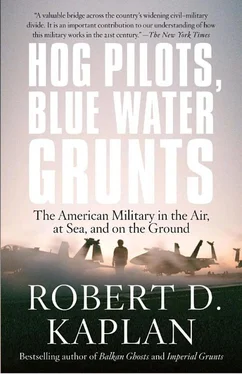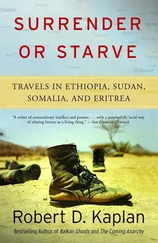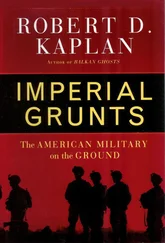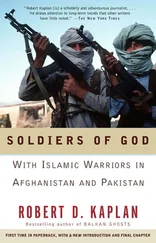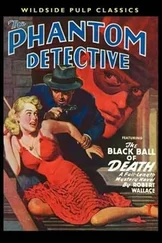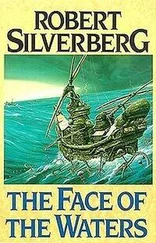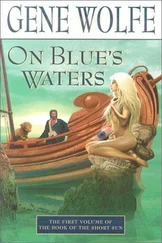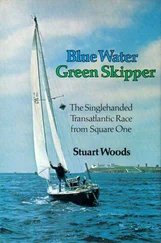First Sgt. Edward Smith of Chicago.
Months later, I received a message from Sgt. Chris Singley—from Fallujah. Soon after he had left Niger, he got his wish: deployment to Iraq as the senior advisor to a company of the new Iraqi Army, which assisted U.S. marines and soldiers during the fighting in the second battle of Fallujah in November 2004. It was a long e-mail, telling me about the 103 Purple Hearts issued as of Christmas Eve 2004, and of the Americans and their Iraqi allies who died there. The few months he had spent in Iraq were clearly the most meaningful of his life.
Named after Hugh Merle Elmendorf, born in 1895 in Ithaca, New York. A pioneer in high-altitude formation flying, he died while test piloting a Y1P-25 in 1933, near Wright Field in Ohio.
The Army had two other Stryker brigades, both based out of Fort Lewis, Washington.
See Chapter 4 of Imperial Grunts for a description of PACOM headquarters overlooking Pearl Harbor, the PACOM area of responsibility, and the Hawaiian island of Oahu’s significance to the U.S. military.
The Missouri was decommissioned for the last time in 1992, during the administration of President Bill Clinton.
Saigon was still the name of the port of Ho Chi Minh City.
H. P. Willmott, Sea Warfare: Weapons, Tactics and Strategy (New York: Hippocrene, 1981), pp. 3–4. The following paragraphs draw significantly from this fine, succinct book.
Anyone who has sailed knows the phenomenon: motoring through the water on a calm day, you may think you have enough wind to sail until you turn off the engine, when you discover that the wind you felt was only that artificially generated by the boat moving through the water under motor.
James (later Jan) Morris, Pax Britannica: The Climax of an Empire (New York: Harcourt, Brace, 1968), pp. 421, 424, 425. In fact, as Morris mentions, the Royal Navy was already past its prime by then, though few in 1897 had the perspective to notice.
Named after Lt. Col. Horace Meek Hickam, born in Spencer, Indiana, in 1885. A graduate of West Point, Lt. Col. Hickam served in the Philippines and in the expedition against Pancho Villa in Mexico. He became an early advocate of airpower in its own right, not merely as an adjunct to ground forces. He was killed in 1934 when his plane hit an embankment at Fort Crockett in Galveston, Texas.
Named after Brig. Gen. James R. Andersen, former chief of staff of the Army Air Forces, Pacific, who was lost at sea in a B-24 crash while returning to Honolulu in 1945.
In all of America’s overseas military deployments, sealift has been responsible for the overwhelming percentage of dry cargo and petroleum supplies.
The term “leathernecks” is often used for U.S. marines. It refers to the leather collars that marines wore earlier in their history to protect them against sword slashes. The leather collars, no longer worn, are symbolized by red stripes on the collars of the Marines’ dress blues.
Named after Lt. Eugene Hoy Barksdale of Goshen Springs, Mississippi, born in 1897 and a veteran of the Somme, Amiens, and Cambrai offensives in 1918. He died in 1926 test piloting a Douglas O-2 at McCook Field, Dayton, Ohio.
The other members of the crew were Jason West of Hawkinsville, Georgia, and Noah Vogt of East Alton, Illinois. The standby crew was Lts. Ricademus Breitwieser of Susanville, California, and Jason Morton of Eddyville, Kentucky, Crew Chief Michael Bageant of Baltimore and Second Crewman Edmund Hooper of San Bernadino, California.
The base was named for a Medal of Honor winner who had jumped on a grenade.
Capt. Philip Treglia of Elida, Ohio. See Chapter 8 in Imperial Grunts.
The South accounts for 40 percent of all Army officers: Greg Jaffe, “A Retreat from Major Cities Hurts ROTC Recruiting,” The Wall Street Journal, February 22, 2007.
For an epic documentation of the sufferings of Australian prisoners of war, including on the Burma-Siam railway, read Ray Parkin’s wartime trilogy: Out of the Smoke, Into the Smother, and The Sword and the Blossom (London: Hogarth, 1960, 1963, 1968).
The hiking trail itself was built by Rodney William Beattie, another Australian.
I spoke with Professor Beaumont, of Deakin University, who was working at the Thai-Burma Railway Centre at the time of my visit to western Thailand. Much of this paragraph reflects her insights, even though her opinion of Prime Minister Howard is less benign than my own.
Named after Maj. Harold M. Clark, born in Minnesota and reared in the Philippines, who was the first U.S. airman to fly in Hawaii. He died in a seaplane crash in the Panama Canal Zone in 1919.
For an excellent briefing on the connection between al-Qaeda and the Philippines, see Maria A. Ressa’s Seeds of Terror: An Eyewitness Account of Al-Qaeda’s Newest Center of Operations in Southeast Asia (New York: Free Press, 2003).
W. Thomas Smith, Jr., “Angels with Rotary Wings,” National Review Online, Jan. 7, 2005. Smith, a former U.S. Marine infantry commander, wrote perhaps the best concise summary of the U.S. military’s relief effort, on which my account is mostly based.
This section on Conrad borrows from my Introduction to Lord Jim and Nostromo (New York: Modern Library, 1999).
The Cole was the next Arleigh Burke destroyer built at Pascagoula, Mississippi, after the Benfold.
The original name was “torpedo boat destroyer.”
An even number would indicate to port of the centerline.
USNS was a designation for Navy ships with mixed crews, of both sailors and civilian merchant seamen.
Beyond “full” was “flank” speed of over thirty knots.
Indeed, not even Britain’s Royal Navy could refuel at sea until 1943, and almost had to let the Bismarck go as a result.
For a heartfelt evocation of conditions on troopships during World War II, see Leon Uris, Battle Cry (New York: Putnam, 1953).
Going unshaven was a privilege that required the individual sailor to make a donation to the ship’s Morale, Welfare, and Recreation (MWR) fund. Also, beard growth had to be trimmed to allow a gas mask to seal onto the face.
In other ways, though, the Navy had a rigid hierarchy. The gulf between a common seaman and an admiral was much greater than that between a grunt and a general in the other services. Moreover, senior noncoms in the Navy were not encouraged to go to Officer Candidate School to the degree that they were in the Army and Marines.
The weapon is actually a CIWS (pronounced “seawhizz”), which stands for Close-In Weapons System; it has a gyroscope and its own radar apparatus for identifying a target. It is a last line of defense against sea-skimming missiles like the Exocet.
Читать дальше
